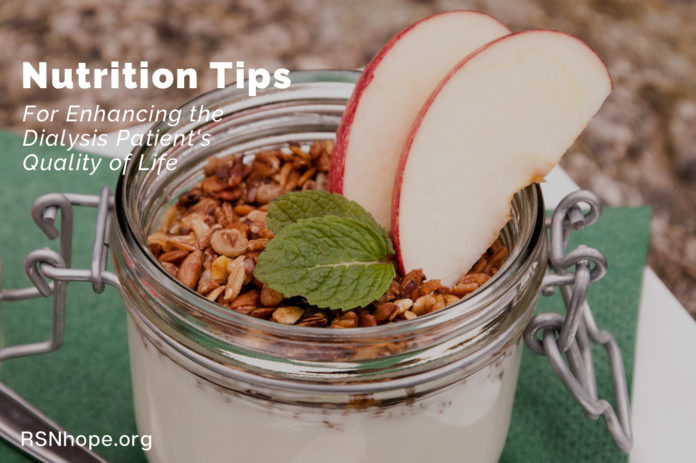Good nutrition is a very important part of your renal treatment plan whether you are on hemodialysis (HD) or peritoneal dialysis (PD). To move forward with your best in all aspects of your life as a kidney patient, make an effort to maintain yourself by eating enough of the right kinds of foods or less (note that I didn’t say avoid) of those “forbidden” foods. Doing your part to ensure that you receive adequate dialysis is also critically important to your overall health and well-being.
Healthy Food Choices
If you are new to dialysis, I’m sure you are finding yourself confronted with many lifestyle changes, including diet. The renal diet can be overwhelming at first. There are many aspects to consider–fluids, sodium, potassium, and phosphorus–that, sometimes, you’re not even sure what to eat!
But you are not alone in your feelings. The good news is that there are many resources to support you as you begin your journey on dialysis. Your healthcare team, especially your renal dietitian, can support you in making healthy food choices.
This article will give you a brief overview of the components of your renal diet and explain why each is important.
What About Protein?
Protein is needed by the body to keep your tissues healthy and replace old or damaged tissue. It is important because it helps the body prevent and fight infection. Proteins are lost during the dialysis process, so it’s important to maintain a diet rich in protein. This could well be different from what you may have been doing before you started dialysis.
There are two kinds of protein:
(1) High quality, or animal, protein comes from milk, meats, chicken, fish, and eggs and contains all the needed ingredients for tissue growth.
(2) Low quality, or plant, protein comes from vegetables, breads, and cereals and is lacking in some of the ingredients tissues need to grow.
You need both kinds of proteins, including at least 50% high-quality protein. Your renal dietitian will figure out your protein needs to include a mixture of both. Your meal plan will include a daily amount of meat, chicken, fish, or eggs or vegetarian choices if you are a vegan.
Fueling With Calories
Calories are necessary for energy and maintaining your body weight. In order for your body to use the protein you eat for growth and repair, sufficient calories are needed.
If you don’t eat enough calories, your body will break down muscle protein and other tissues for energy. Just as fuel gives power to cars, calories fuel your body and give you energy.
Potassium For the Heart
Potassium is a mineral important for regulating your heart. Limiting potassium is generally not necessary before you start dialysis. However, when your kidneys are not working 100% and are unable to get rid of extra potassium, you will be asked to limit this component of your diet.
The amount of potassium allowed will be individualized based on the level of it in your blood as well as your urine output. Some foods high in potassium include bananas, tomato products, oranges, orange juice, exotic fruits, and potatoes. This is not to say that you can never have a glass of orange juice again. Work with your dietitian on how to incorporate some of your favorite foods into your meal plan. It is possible!
Phosphorus For the Bones
As kidneys fail, they lose their ability to keep calcium and phosphorus in balance. Phosphorus is a mineral that combines with calcium in the body to keep your teeth and bones strong. Unlike potassium, however, phosphorus is not very well removed by dialysis. High phosphorus levels can eventually lead to calcium and phosphorus deposits in the heart, skin, joints, and blood vessels.
To prevent this from occurring, phosphorus must be controlled through diet and phosphate binders. The key to phosphorus control is:
- Diet;
- Take phosphate binders with all meals and snacks; and
- Dialysis.
Phosphorus is found in almost all foods, but is especially high in dairy products, cheese, dried beans, liver, nuts, and chocolate.
Fluid Balance and Removal
Healthy kidneys maintain fluid balance and prevent swelling in feet, ankles, legs, hands, or face. When the kidneys lose their ability to get rid of extra fluid, the extra water can raise blood pressure, cause strain on the heart, and make it hard to breathe.
One of the primary goals of dialysis is fluid removal. Less fluid gained between treatments results in a better-tolerated treatment and is easier on the heart. Higher fluid gains can lead to cramping during dialysis and possibly longer treatment times (some people may need an extra treatment if not all of the water weight is removed). The goal for fluid gain should be no more than 1-2 pounds per day between dialysis treatments.
The fluid allowance for HD is determined by the amount of urine produced in a 24-hour period. Most people are limited to 700-1000 ml of fluid per day plus urine output. For example, if you urinate 500 cc, your total daily fluid allowance would be 1200 cc (500 + 700). Fluid allowances vary from person to person. Other considerations include how much the remaining kidney function is left and the person’s body size.
Controlling Fluid Intake
Tips for controlling thirst and your fluid intake include the following:
- Ice lasts longer in your mouth than liquid. Make sure to measure ice as fluid.
- Use small cups or glasses instead of large ones. Know how much your favorite glasses or cups hold.
- Suck on hard candy or mints.
- Chew gum. Make sure it’s sugarless gum if you are diabetic.
- Add a drop of lemon juice to water or suck on a lemon wedge.
- Rinse your mouth without swallowing.
- Keep mouthwash in the refrigerator and rinse the inside of your mouth occasionally to refresh and moisten it.
- Try very cold, low potassium fruit such as frozen grapes.
- Eat bread with margarine and jelly, or applesauce (but, again, watch the sugar in jelly or applesauce if you are diabetic).
- If you are diabetic, keeping your blood sugars in control can help reduce thirst.
Sodium and Salt Substitutes
Sodium is limited to control thirst and keep blood pressure under control. Generally speaking, food can be cooked with a small amount of salt, but no additional salt should be added to foods at the table. Salt substitutes should not be used as they contain a lot of potassium.
Moderation: Don’t Overdo It!
The 2005 Dietary Guidelines for Americans emphasizes the importance of eating a wide variety of foods. This applies to dialysis patients, too. Patients can enjoy all foods in moderation while following a renal diet. Remember to be sensible, enjoy all foods, and don’t overdo it.
Following are some tips for not overdoing it:
- Slow down while eating. It takes 20 minutes to send the signal that you’ve had enough to eat.
- Stop eating when you feel full. You should walk away from the table feeling that you can eat a little bit more.
- Have one small helping of that chocolate cake and enjoy every bite.
- When eating out, enjoy that piece of lasagna twice as much. Eat only one-half of the food you get in the restaurant and “doggy bag” the rest home to enjoy the next day. (Of course, phosphate binders will need to be adjusted accordingly).
Conclusion
The ultimate goal for people with chronic kidney disease (CKD) should be a healthy lifestyle that can be maintained in the long run, rather than a short-term “diet” that will most likely be abandoned and produce psychological discomfort. It’s all about making changes that will last a lifetime–changes that are focused on smart, sensible eating.
 About the Author
About the Author
Maria Karalis, MBA, RD, LDN, is a Nutrition Consultant and Writer and has worked in the nephrology field for 19 years. She enjoys writing for healthcare professionals and people with chronic kidney disease (CKD) with one goal in mind: helping CKD patients live their life to the fullest. This article has been updated to reflect the latest research and was originally published on the iKidney.com website, supported by Watson Pharma, Inc.
Web ID 373







